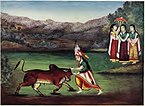Indian epic poetry is the epic poetry written in the Indian subcontinent, traditionally called Kavya. The Ramayana and the Mahabharata, which were originally composed in Sanskrit and later translated into many other Indian languages, and the Five Great Epics of Tamil literature and Sangam literature are some of the oldest surviving epic poems ever written.
Indian literature refers to the literature produced on the Indian subcontinent until 1947 and in the Republic of India thereafter. The Eighth Schedule to the Constitution of India has 22 officially recognised languages. Sahitya Akademi, India's highest literary body, also has 24 recognised literary languages.

Meitei, officially known as Manipuri, is a Tibeto-Burman language of northeast India. It is the official language and the lingua franca of Manipur, as well as one of the 22 official languages of the Indian Republic, included in the 8th Schedule to the Indian Constitution. It is one of the advanced literary languages, recognised by Sahitya Akademi, India's National Academy of Letters. It serves as one of the recognised educational and literary languages in Assam and Tripura. Native to the Meitei people, it has around 3 million total speakers, and is used as L1 by around 1.8 million people, predominantly in the state of Manipur, and as L2 by different ethnic groups, in different parts of India, Myanmar and Bangladesh. It was used as a court language in the historic Manipur Kingdom, in accordance to the Manipur State Constitution Act 1947.

The Meitei people, Meetei people, or Manipuri people is an ethnic group native to Manipur. They form the largest and dominant ethnic group of Manipur in Northeast India. They speak the Meitei language, one of the 22 official languages of the Indian Republic and the sole official language of Government of Manipur. The Meiteis primarily settled in the valley areas in modern-day Manipur, though a sizeable population has settled in the other Indian states of Assam, Tripura, Nagaland, Meghalaya, and Mizoram. There is also a notable presence of Meitei people in the neighbouring countries of Myanmar and Bangladesh. The Meitei ethnic group represents about 53% of Manipur's population.

The Meitei script, also known as the Meetei script, is an abugida used for the Meitei language, the official language of Manipur state and one of the 22 official languages of India. It is one of the official scripts of the Indian Republic. It is also popularly known as the Kanglei script and the Kok Sam Lai script. Its earliest known evidence of existence dates back to the 6th century AD coins, engraving the Meitei letters, as verified by the various publications of the National Sahitya Akademi. It was used until the 18th century, when it was replaced by the Bengali alphabet. A few manuscripts survive. In the 20th century, the script has experienced a resurgence, and is again being used. Starting from 2021, Meitei script was officially used by the Government of Manipur, along with the Bengali-Assamese script, to write the Meitei language, as per "The Manipur Official Language (Amendment) Act, 2021".

The Indian classical languages, or the Shastriya Bhasha, is an umbrella term for the languages of India having high antiquity, and valuable, original and distinct literary heritage. The Republic of India officially recognises six languages as the Classical languages of India. In 2004, the Government of India declared that languages that met certain strict criteria could be accorded the status of a "Classical Language" of India. It was instituted by the Ministry of Culture along with the Linguistic Experts' Committee. The committee was constituted by the Government of India to consider demands for categorization of languages as Classical Languages.
Cheitharol Kumbaba, or Cheithalon Kumpapa (Ch.K.), the "Royal Chronicle of Manipur" is a court chronicle of the kings of Manipur, which claims to start from 33 CE and to cover the rule of 76 Kings until 1955. The work of chronicling actually began during the reign of King Kiyamba in 1485 CE. The earlier events were reconstructed later during the reign of Bhagyachandra, presumably from oral sources or from scattered written records. According to scholar Saroj Nalini Parratt, the earlier parts have relatively little detail but contain numerous inaccuracies. But they are still said to be useful in reconstructing Manipur's early history.
Ningthoukhongjam Khelchandra Singh was an Indian writer, lexicographer and historian, known as the author of Manipuri to Manipuri and English, the first modern general dictionary in Meitei language, which was published in 1964. He was a fellow of the Sahitya Akademi and Sangeet Natak Akademi. The Government of India awarded him the fourth highest civilian honour of Padma Shri in 1987.

Nongshaba, also spelled as Nongsaba, is a Lion God in Meitei religion (Sanamahism) and mythology. He is also regarded as a king of the gods. He is credited with producing light in the primordial universe and is regarded as the maker of the sun. He is worshipped by the people of both the Ningthouja clans as well as the Moirang clans. God Nongshaba was worshipped by the people of Moirang clan as a lineage deity and regarded as the father of God Thangching (Thangjing). He is the greatest of the Umang Lais in Ancient Kangleipak but he made his only son Thangching (Thangjing) the chief deity of Moirang.

King Loiyumba, also known as Meidingu Loiyumpa, was a Meitei monarch and a ruler of Kangleipak kingdom. He was the first king to order a written constitution in the 11-12th century CE which is known as the Loiyumpa Silyel .
Puya Meithaba, or Lairik Meithaba, refers to the annual commemoration of a legendary 18th-century scripture burning in post-colonial Manipur, or to the original libricide of Puya itself. There is no historical evidence that the libricide was planned, much less that it did happen. Nonetheless, the commemoration, organised by the Meitei National Front and others since 1979, has been a critical tool in the spread of Meitei nationalism and has mainstreamed a particular reconstruction of premodern Manipur, which has come to be uncritically reproduced even in academic publications.

Ancient Kangleipak was an ancient, lesser known civilisation, concentrated along the central plains of the modern day Kangleipak (Manipur), India. The Kangla served as the foremost capital city of this realm from the 15th century BCE, up to the medieval times.

Meitei mythology or Manipuri mythology is a collection of myths, belonging to the religious and cultural traditions of the Meitei people, the predominant ethnic group of Manipur. It is associated with traditional Meitei religion (Sanamahism). Meitei myths are a part of Meitei culture and explain various natural phenomena, how the human civilization developed, and the reasons of many things happening. Most of the Meitei legends are found in the Meitei language texts.

The ancient legend of Khuyol Haoba and Yaithing Konu is one of the epic cycles of incarnations of Meitei mythology and folklore, that is originated from Moirang kingdom of Ancient Kangleipak. It concerns the fateful love of Khuyol Haoba, an orphan man, for the beautiful Yaithing Konu. Khuyol Haoba was the son of late Khundouremba, a court official of Moirang. Yaithing Konu was the daughter of Luwang Huiningsumba, an influential nobleman of Moirang.

The ancient legend of Ura Naha Khongjomba and Pidonnu is an epic cycle of incarnations of Meitei mythology and folklore from the Moirang kingdom of Ancient Kangleipak. It concerns the love and adventures of the forgotten prince Ura Naha Khongjomba for the beautiful woman Pidonnu.
Meidingu Naokhamba was a ruler of Ancient Manipur. He is the successor of Kaokhangba and the predecessor of Naophangba. During his reign, Manipuri traders reached out on horseback to upper Burma and China. Besides the Cheitharol Kumbaba and the Ningthourol Lambuba, he is also mentioned in the Chengleiron. Naokhamba abducted the wife of King Thangyi Khongjromba of the Chenglei tribe when she was heavily pregnant. Later, she had a son named "Naophang Ahanba". During his reign, Chingjen Naran Panggalba, the king of the Chengleis left Kangleipak for westward lands.
Khui Ningomba was a ruler of Ancient Manipur. He was the successor of Emperor Taothingmang.

The Loiyumpa Silyel, also termed as the Loyumpa Silyel or the Loiyumpa Shilyel or the Loyumpa Shilyel or the Loyamba Sinyen, is an 11th-12th century ancient Meitei language written constitution, regulated in the Ancient Kangleipak during the rule of King Loiyumba. In 1110 CE, its format was finalised from a promulgation of the proto-constitution, drafted in 429 CE by King Naophangba. Historically, it is the first written constitution, and one of the well recorded Ancient Meitei language texts of the kingdom. Its Constitutionalism was replaced by the Manipur State Constitution Act 1947, that was functional until Manipur was merged into Republic of India on October 15, 1949.

Ancient Meitei literature, also termed as Old Manipuri literature, is literature written in the Ancient Meitei language from the earliest texts until the time of King Pamheiba of Kangleipak. All the ancient Meitei literary works are written in the traditional Meitei script. The ancient Meitei language texts, written in Meitei script, are conventionally termed as "the Puyas".



















